The
Christchurch Park cenotaph
A cenotaph is a word with a Greek derivation; is an empty tomb
or a monument erected in honour of a person or group of people whose
remains are elsewhere. Although the vast majority of cenotaphs honour
individuals, many noted cenotaphs are instead dedicated to the memories
of groups of individuals, such as the lost soldiers of a country or of
an empire.
The cenotaph in the Britain that stands in Whitehall, London was
designed
by Sir Edwin Lutyens and replaced Lutyens' identical wood-and-plaster
cenotaph erected in 1919 for the Allied Victory Parade; it is a Grade I
listed building. It is undecorated save for a carved wreath on each end
and the words "The Glorious Dead," chosen by Lloyd George. It was
intended to commemorate specifically the victims of the First World
War, but is used to commemorate all of the dead in all wars in which
British servicemen and women have fought. The dates of the First World
War and the Second World War are inscribed on it in Roman numerals. The
design was used in the construction of many other war memorials
throughout the British Empire.
Meanwhile in Ipswich, on the flat area of Christchurch Park to the west of the
Mansion, stands an austere modernist cenotaph which tapers upwards from
the base.
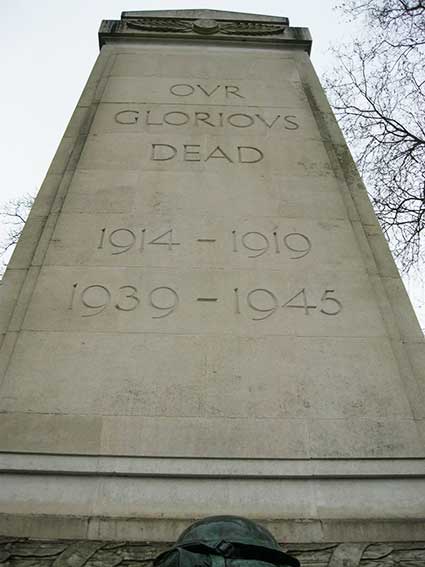
 2017 images
2017 images
'OVR
GLORIOUS
DEAD
1914 - 1919
1939 - 1945'

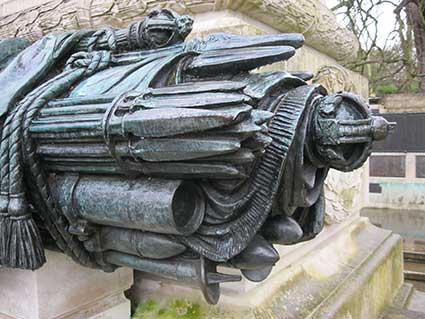
'The Cenotaph of Portland stone echoes that in Whitehall by Sir
Edward Lutyens unveiled four years earlier both in design and in its
inscription to the Glorious Dead. However the Ipswich Cenotaph is set
in front of a low stone wall – resembling an altar wall – with bronze
plaques inscribed with the names of the dead and has a bronze memorial
sarcophagus with rounded top in front. The [bronze] sarcophagus which
was inspired by Renaissance
models with two feet on a plinth is made up of up of weaponry including
including bundles of spears, regimental standards, bandoliers of
ammunition, maces, machine-guns and a Stokes gun – invented by Sir
Wilfred Scott-Stokes (1860-1927) who was the managing director of the
engineering firm Ransome & Rapier of
Ipswich. The draped Union Jack and flag of St George shows respect for
the dead whose victory is suggested by laurel discretely growing around
the knapsack and bayonet. At the top is a rifle and British army round
helmet accompanied the rest of the soldier’s equipment: gas mask, water
bottle and ammunition belt.' The Public Sculpture of Norfolk &
Suffolk website (see Links)
Note: we think that there are four feet on the plinth.
The plinth is incribed:
'THE GREAT WAR
1914
1919
1939 WORLD WAR II 1945'

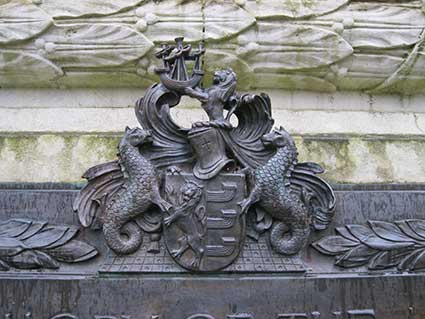
On the reverse of the cenotaph base is a nicely crafted
metalwork
plaque with the Town coat of arms above the
following inscription:
'IN GRATEFVL MEMORY OF THE
MEN OF IPSWICH
WHO GAVE THEIR LIVES FOR THEIR COUNTRY
THIS MEMORIAL
AND THE HOSPITAL WAR MEMORIAL WING
WERE ERECTED BY THEIR FELLOW CITIZENS'
Facing this plaque, across a paved platform, is a curtain wall
bearing the actual list of those killed in the two World Wars inscribed
on metal panels. The small panel below reads:
'Conflicts Post-1945
LT. SWINBANKS, B. Royal
Engineers Korea 1951
PTE. MCDONALD, R.H. Royal
Norfolk Rgt. Korea 1952
L/Bdr. BRETTELL, M.A. Royal Artillery
Korea 1952
FO. BANYARD, K.W. Royal Air Force
Cyprus 1956
PTE. BARNES, G.I. Parachute
Rgt. N.Ireland 1979
PTE. MCCLURE,
A.J. Royal Anglian
Regt. Afghanistan 2007'
The shortness of the above list may come as some comfort to
those who compare the volume of soldiers killed in action in modern
times with those of the wars up to 1945.
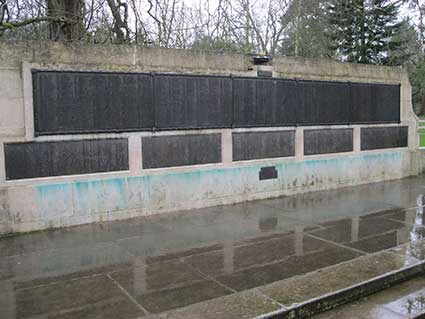

At the top of the curtain wall is a rather nice metalwork
burning oil lamp with angel handle, to indicate the eternal flame which
was maintained at the tomb of the unknown soldier.
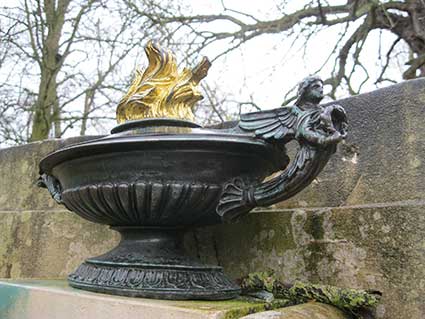
The unveiling in 1924
Press coverage of the unveiling of the war memorial on 6
May 1924:-
'Although the memorial has previously been described in the
East Anglian Daily Times, it
should briefly be stated the cenotaph and
the panels containing the names of the fallen constitute only one phase
of the tribute which Ipswich is paying to its sons who fell in the war.
What must be considered as the practical part of the Borough War
Memorial is the new wing to the East Suffolk
and Ipswich Hospital,
which combined with the East Suffolk war memorial, provides a valuable
and much needed addition to that worthy institution. Work is steadily
proceeding in connection with the Hospital scheme, and it is hoped that
the memorial wing will be formally opened in the early Autumn. While,
for purely financial reasons, the new buildings are hardly on the scale
which was originally visualised by the Secretary to the Hospital (Mr.
Arthur Griffiths). The amended plans nevertheless retain the essentials
of the original scheme, and the extension will, in every sense, be a
worthy commemoration of the valour and self sacrifice of the men of
Ipswich during the war.
The Christchurch Park Memorial takes the form of a cenotaph backed by a
screen wall, bearing bronze panels, on which are cast in block
projecting letters the 1,481 names of the fallen, together with their
units and branches of the Forces in which they served. The decoration
of the screen is in a laurel wreath design, and in the centre of the
wall is a symbolical bronze casting of a Greek lamp. The cenotaph is,
in a sense, separated from the area devoted to the tablets, for these
may be approached from separate flights of stone steps. The
plinth of the cenotaph, which is inscribed to “Our Glorious Dead” is
approached by five steps, and the observed can not but be impressed by
the fine conception of the bronze trophy of arms in the foreground, the
symbolising the accoutrements of the war laid astride. It is built up
of equipment, including regimental standards, bundles of lances,
machine-guns and a Stokes trench gun, with tripod and shells.
Incidentally, it may be observed that the inclusion of the Stokes gun
(invented by the distinguished Ipswich engineer, whose name it bears)
is especially appropriate, reflecting, as it does, anther side of
the many contributions of the town towards the herculean national
effort which ultimately secured the victory for our arms. The trophy is
bound together with representations of cords, and draped with the Union
Jack and St. George’s Banner. In its centre is depicted the familiar
personal equipment of the soldier – a haversack, trenching tool, water
bottle and gas mask, interwoven with stems of oak and laurel leaves,
and surmounted by a rifle and helmet. On the rear side of the memorial
is the dedication tablet, surmounted by the Borough Arms, and bearing
the words, “In grateful memory of the men of Ipswich who gave their
lives for their country, this memorial and the Hospital war memorial
wing were erected by their fellow citizens.”
Mr Edward Adams, A.R.I.B.A., of Manchester was responsible for the
design of the memorial, which was thrown open to competition by all
British architects, over 200 of whom submitted drawings. The underlying
principle of Mr. Adams’s conception is repose, obtained by the
horizontal distribution of the masses of the screen, broken and
contrasted by the vertical mass of the cenotaph, the general effect
being rather severe. The memorial stands on raising ground, in a
sheltered and quiet corner of the park, and it has as its setting a
group of magnificent poplars in the rear. Constructed in Portland
stone of particularly fine quality, it does infinite credit to the
contractors, Messrs. Collins and Curtis, of Ipswich, a firm in which
both partners are ex-service men. The bronze work was executed with
great care by Messrs. Earp, Hobbs and Miller, sculptors, of Manchester,
and the ensemble adds richly to the beauties of the park. The
foreground, the path leading to the cenotaph, and the “surround” were
executed by the Borough Surveyor (Mr. S. Little) and his department.
The suitability of the site of the memorial for the commemoration
services which will undoubtedly be held in its vicinity in years to
come was amply demonstrated on Saturday, when the large congregation in
close proximity to the cenotaph was able to take its full share in the
memorable service. Obviously it was impossible to provide special
accommodation for all the many thousands who attended, but reserved
enclosures were provided for the relatives of the fallen, for soldiers
in uniform but not on parade and ex-service men wearing medals, and for
those who are closely associated with the civil life of Ipswich. It was
a graceful act on the part of several large subscribers to the memorial
fund to stand aside on Saturday in order that those who were intimately
concerned with these valiant men of Ipswich might have the facilities
which were their just due, and the ladies and gentleman who were
mingled with the throng on the outskirts of the enclosures are to be
commended for their kindly consideration that they showed. Through the
distribution of many hundreds of copies of the order of service,
however, all were enabled to follow the proceedings intelligently and
reverently, and it was, indeed, with a striking reverence that the
throng took up the opening lines of Kipling’s
“Recessional,” sung to the time-mellowed tune, Melita.'
The above selected description of the cenotaph unveiling is to be found
in full on the Ipswich War Memorial website (see Links).
See also our page on Christchurch Mansion
and Park (including the nearby Boer War memorial), the Withypoll Memorials
stone.
Also the Ipswich Martyrs memorial in
the park; the Christchurch timeline.
Home
Please email any comments
and contributions by clicking here.
Search Ipswich
Historic Lettering
©2004
Copyright
throughout the Ipswich
Historic Lettering site: Borin Van Loon
No reproduction of text or images without express written permission

 2017 images
2017 images





